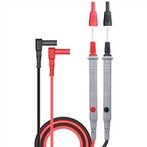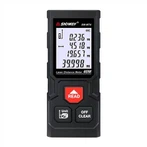Units used for measuring illuminance
Units for illuminance meters
Many customers will say, I want to buy a light meter, and they will naturally ask what the unit of the light meter is! Now let's briefly introduce illuminance. Illuminance is a unit that reflects the intensity of light. Its physical meaning is the luminous flux illuminated on a unit area. The unit of illuminance is the number of lumens (Lm) per square meter, also called Lux: 1Lux=1Lm/m2. As can be seen from the above formula, Lm is the unit of luminous flux, which is defined as the amount of light radiated by a surface area of 1/60 square meters of pure platinum within a solid angle of 1 steradian at the melting temperature (about 1770°C).
The above explanation of illuminance units seems very theoretical and generally difficult to understand. In order to have a more perceptual understanding of the amount of illumination, for example, a 100W incandescent lamp emits a total luminous flux of about 1200Lm. If it is assumed that the luminous flux is evenly distributed on a hemisphere, then the distance from the light source The illuminance values at 1m and 5m can be obtained according to the following steps: The area of a hemisphere with a radius of 1m is 2π×12=6.28 m2, and the illuminance value at 1m from the light source is: 1200Lm/6.28 m2=191Lux. In the same way, the area of a hemisphere with a radius of 5m is: 2π×52=157 m2, and the illumination value at a distance of 5m from the light source is: 1200Lm/157 m2=7.64Lux.
General conditions: In summer, the illuminance is about 100000LUX in the sun; the outdoor illuminance on a cloudy day is 10000LUX; the indoor daylight illuminance is 100LUX; the illuminance on our desktop 60cm away from the 60W desk lamp is 300LUX; the illuminance in the TV live broadcast room is 1000LUX; in the room at dusk The illuminance is 10LUX; the illuminance of street lights at night is 0.1LUX; the illuminance of candlelight (at a distance of 20cm) is 10~15LUX.
Having said this, everyone should have a more perceptual understanding of the light meter unit. In fact, the application of light meters is very wide, such as factories, schools, libraries, business buildings, hotels, commercial exhibition halls, laboratories, computer rooms, etc. , these places all use illuminance meters. It can be exaggerated to say that as long as there is bright light, it is possible to use illuminance meters to measure the current illumination. Now I will give you a more suitable reference value for the illumination of places.
Sunny day: 30000~300000LUX Production workshop 10~500LUX
Cloudy day: 3000LUX Office 30~50LUX
Sunrise and sunset: 300LUX restaurant 10~30LUX
Full moon: 0.3~0.03LUX Corridor 5~10LUX
Starlight: 0.0002~0.00002LUX parking lot 1~5LUX
Dark night: 0.003~0.0007LUX
Under normal circumstances, we are more comfortable in an illumination environment of about 250-750 LUX. Too high or too high illumination will also cause damage to human eyes. The most direct cause is myopia. The vast majority of myopia occurs when the illumination is very low. Reading for a long time in an environment or overusing your eyes is something we should pay attention to.
Illuminance meter units and application conditions
Application scope of light meter
Illuminance is closely related to people's lives. For example, adequate lighting can prevent people from accidents. On the contrary, too dark light can cause fatigue to the human body far beyond the eyes themselves. Therefore, uncomfortable or poor lighting conditions are one of the main causes of accidents and fatigue. Existing statistics show that about 30% of all occupational labor accidents are caused directly or indirectly by insufficient light. The lighting of sports venues (venues) must be very strict. Too strong or too dark light will affect the effect of the game.






